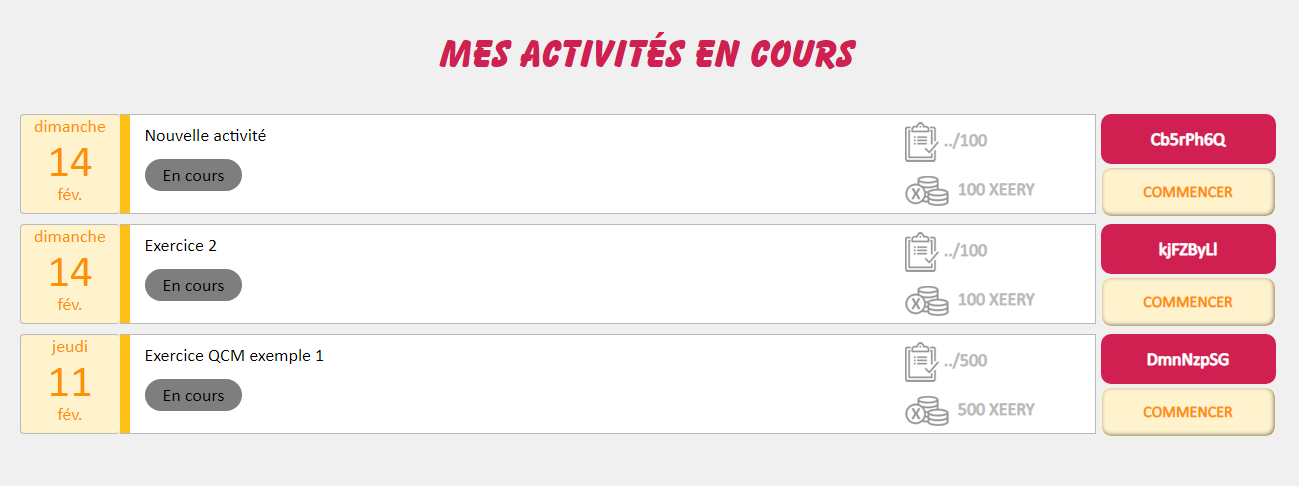Réception du code
L’étudiant reçoit le code envoyé par son enseignant via le cours, par mail ou en visioconférence. Il l’encode alors sur sa page d’activités pour l’ajouter et peut soit l’entreprendre immédiatement, soit l’enregistrer pour la réaliser plus tard.

Gestion des activités
L’étudiant possède un espace avec une vue sur l’ensemble de ses activités. Il peut consulter celles en cours, celles qu’il lui reste à faire et celles déjà réalisées. Quand il entreprend une activité, il peut l’interrompre à tout moment pour la continuer plus tard.

Remise des résultats
Quand l’étudiant termine une activité, les points s’affichent automatiquement pour les réponses qui ont été préalablement encodées par son enseignant. Il l’envoie et, après correction, reçoit sa cotation et ses Xeery obtenus. Il pourra alors dépenser ces derniers dans son école virtuelle pour customiser son avatar et sa classe.

L’école virtuelle
L’école virtuelle est un endroit où les étudiants pourront librement se promener dans un espace spécialement conçu pour eux. Il s’agit de salles de classe où ils pourront voir les autres étudiants, interagir avec eux ainsi qu’avec des personnages non-jouables. Avec les Xeery amassés durant leurs activités ou en remplissant des missions, ils peuvent également customiser leur avatar ou leur salle de classe.

1. Première connexion
Quand l’étudiant se connecte à son école virtuelle pour la première fois, il est invité à répondre à des questions en rapport avec sa personnalité. Ses réponses vont générer pour lui un premier avatar et lui associer une animation par rapport à son état d’esprit actuel.

2. Environnement
Quand l’étudiant se rend dans son école virtuelle, il se retrouve sous forme d’avatar dans un environnement où il peut se promener librement dans des salles de classe. Il peut également y croiser les autres étudiants. Chaque avatar affiche des animations en fonction de son humeur du jour.

3. Customiser l’avatar
L’étudiant peut à tout moment customiser son avatar avec les options de personnalisation qu’il possède. Il peut en posséder plus en dépensant des Xeery obtenus après avoir rendu des activités ou rempli des missions. Les choix sont directement sauvegardés et appliqués sur le modèle 3D visible par les autres étudiants.
4. Customiser l’école virtuelle
S’il possède assez de Xeery spéciaux, l’étudiant peut faire une proposition de changement ou d’amélioration de son école virtuelle (repeindre les murs, décorer, etc.). Il soumet alors son idée à un vote de groupe. Si la proposition est approuvée par la majorité de la classe, la modification est appliquée pour l’ensemble des étudiants.

5. Les missions
Au sein de l’école virtuelle, certains personnages ou décors permettent d’enclencher des missions. Celles-ci sont en relation avec les bons gestes à adopter afin de développer un environnement sain en classe (tri des déchets, rapporter un téléphone perdu, etc.) En réalisant les missions, l’étudiant est récompensé par des Xeery à échanger contre des customisations d’avatar.

